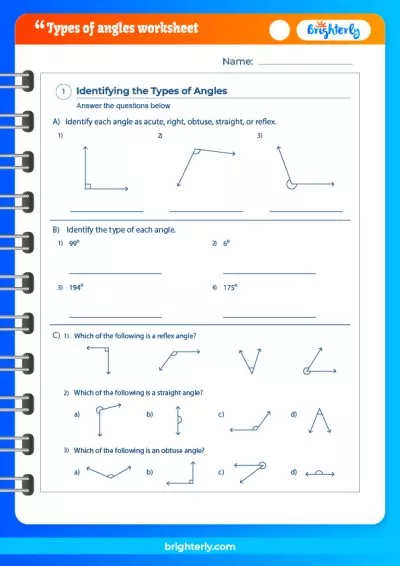Types of Angles – Formula, Based on Measurement
Updated on January 8, 2024
Welcome to Brighterly, your trusted source for making math learning engaging and accessible for children. In this article, we delve into the world of angles—a key concept in geometry. We’ll explore various types of angles, their measurements, and practical applications. Brighterly is dedicated to simplifying complex math topics, making them easy and fun for kids to learn.
Types of Angles
Angles are a basic yet essential concept in mathematics, particularly in geometry. An angle is created when two rays meet at a common endpoint, known as the vertex. The rays are the sides of the angle. Understanding different types of angles is crucial in solving a variety of geometric problems.
Types of Angles Based on Measurement
Angles are classified by their measurement in degrees, a unit for measuring angles, akin to measuring length in inches or centimeters.
Acute Angle
An acute angle is any angle less than 90 degrees. It resembles a sharp, narrow angle. For example, if an angle measures 45 degrees, it’s an acute angle. Formula: .
Right Angle
A right angle is an angle of exactly 90 degrees, resembling the corner of a square. It’s denoted by a small square at the vertex in diagrams. For instance, two perpendicular lines intersecting create a right angle. Formula: .
Obtuse Angle
An obtuse angle is greater than 90 degrees but less than 180 degrees. It’s wider than a right angle. For example, an angle of 120 degrees is obtuse. Formula: .
Straight Angle
A straight angle measures exactly 180 degrees, appearing as a straight line. This happens when the sides of an angle form a line. Formula: .
Reflex Angle
A reflex angle is more than 180 degrees but less than 360 degrees. It’s larger than a straight angle. An angle of 220 degrees, for example, is a reflex angle. Formula: .
Full Rotation Angle
A full rotation angle is precisely 360 degrees, representing a complete circular turn. This is like the motion of a clock’s hands returning to the same point. Formula: .
Examples of Angle Formulas in Use
- Acute Angle in Architecture: Designing a roof with a 30-degree angle for optimal water runoff.
- Right Angle in Construction: Ensuring walls meet at 90 degrees for structural stability.
- Obtuse Angle in Art: Drawing a landscape with a 120-degree angle to create perspective.
Practical Applications of Different Types of Angles
Angles find applications in various domains. Architects use them for building designs, while artists employ them for perspective in their artwork. In sports, understanding angles can influence the trajectory in games like soccer or basketball.
Practice Questions on Types of Angles
- Identify the type of angle if it measures 135 degrees. (Answer: Obtuse Angle)
- What type of angle is formed by the hands of a clock at 3 o’clock? (Answer: Right Angle)
- Calculate the angle type when two rays create a straight line. (Answer: Straight Angle)
FAQs on Types of Angles and Their Formulas
What defines an acute angle?
An acute angle measures less than 90 degrees.
How is a right angle different from an obtuse angle?
A right angle is exactly 90 degrees, while an obtuse angle is greater than 90 degrees but less than 180 degrees.






